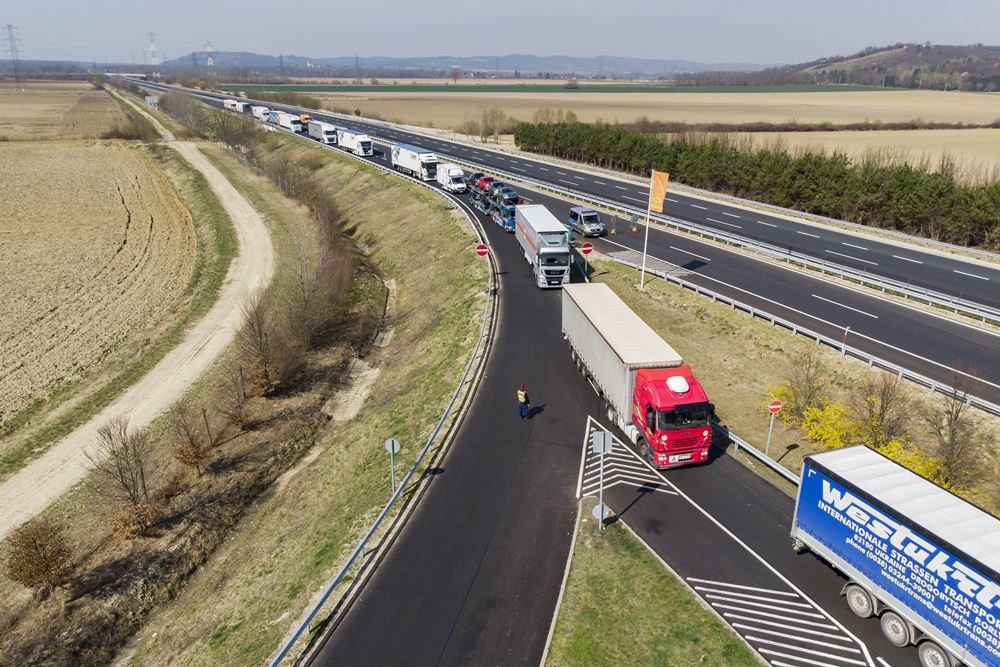Driver’s work is inseparable from time. One could even say that for a professional driver, a much more important device to measure time is the tachograph rather than a watch or a clock. And it is precisely time in the era of coronavirus pandemic that is the nightmare of every transport company, and above all of the drivers. What to do when a truck gets stuck in a traffic jam at the border that is tens of kilometres long?
In connection with the coronavirus pandemic, thorough border controls have contributed to congestion at road crossings. And it has directly translated into violations of drivers’ working time standards.
A professional driver very often encounters many obstacles on the road – an accident, a closed section of the road, detours. These situations contribute to the formation of traffic jams, and one could say that this is an everyday reality for the driver.
From the very beginning of its existence, Regulation No 561 of 2006 provides for situations where a driver may have difficulty in meeting working time standards. What is currently happening on border roads is unique in terms of the pandemic itself, but in terms of regulations and driver behaviour, it is perfectly normal. No matter if the congestion extends for 2, 5 or 50 kilometres – the driver can refer to the same rule every time. More specifically, Article 12 of Regulation 561/2006.
Magic 12, or how to take advantage of derogations
In a situation where a driver is forced (i.e. the situation on the road forces him to continue driving, and this is not a result of his arbitrary behaviour in order to e.g. drive home without taking a rest), for example, to continue driving without taking a mandatory rest, because there is nowhere to leave the vehicle or there is no way he can rest because he is in a traffic jam, he can invoke the provisions in Article 12.
Provided that road safety is not thereby jeopardised and to enable the vehicle to reach a suitable stopping place, the driver may depart from Articles 6 to 9 to the extent necessary to ensure the safety of persons, of the vehicle or its load. The driver shall indicate the reason for such departure manually on the record sheet of the recording equipment or on a printout from the recording equipment or in the duty roster, at the latest on arrival at the suitable stopping place.
So what exactly should a driver do? Get prepared!
If we are talking about a traffic jam that the driver is aware of, and we are well aware that today’s technology fully provides him with the right information, he should first of all take care to have as many minutes of ‘available driving’ as possible when the jam begins. Such a solution will not, of course, fully eliminate the problems of drivers, but it may significantly reduce the time by which they will have to exceed their driving time.
And so, while knowing about the traffic jam, stop in the nearest possible place, take a proper rest and continue driving. Such behaviour, at first glance, shows the inspector that you are making every effort to comply with Regulation 561.
Driver’s working time – when prevention is not enough
When, despite his efforts, a driver gets stuck in an exceptionally long traffic jam, such as the one currently occurring around border crossings, he can resort to Article 12 of Regulation 561/2006. He should carefully follow the procedure below:
1.
When the driver runs out of available driving time, he should print out data from his tachograph, e.g:
12/561/2006
Covid-19 border crossing point at [town] (check), unable to use a parking lot, drive up to the DE/PL border.
2.
While continuing the drive in the traffic jam, from time to time (e.g. every hour or two), he should make additional print outs, e.g:
12/561/2006
Covid-19 border crossing point at [town] (check), still unable to use a parking lot, drive up to the DE/PL border.
3.
When he crosses the border, he should immediately look for a place to stop, which will allow him to take the due rest. If there is no such place, he should again make a print out, e.g.:
12/561/2006
Lack of free parking spaces in the parking lot at [town]/at the interchange/at a motorway service area (MOP), continuation of the drive to find a parking space.
Drivers’ Lucky Twelve
The most important thing is that we take into account the fact that different countries introduce exemptions from punishment on their territory, not exemptions from the rules. Guidance on whether or not checking of compliance with this or another provision has been abolished applies only to the country concerned. In other countries the standards of Regulation 561/2006 are normally in force and the only document to justify exceeding the working time standards is a printout from the driver card together with a description of the reason for the non-compliance (COVID-19). The rules described in Regulation 561/2006 should therefore continue to be strictly applied.
In situations that require it, use print outs, scrupulously document and describe the situation encountered on the road in order to be able to document the circumstances during checks in Poland and abroad. Importantly, the meticulous approach to the subject and reasonable application of Article 12 also affects the interpretation of the situation during inspections.
Imagine a situation in which a driver encounters a traffic jam but only makes an entry after 5 hours or when he stops the vehicle in a parking lot. It clearly shows the services that he did not seek a solution, did not try to fulfil his obligations under the Regulation. Taking preventive actions and their meticulous recording is much better than ignoring regulations.
Photo: MTI/Varga György









